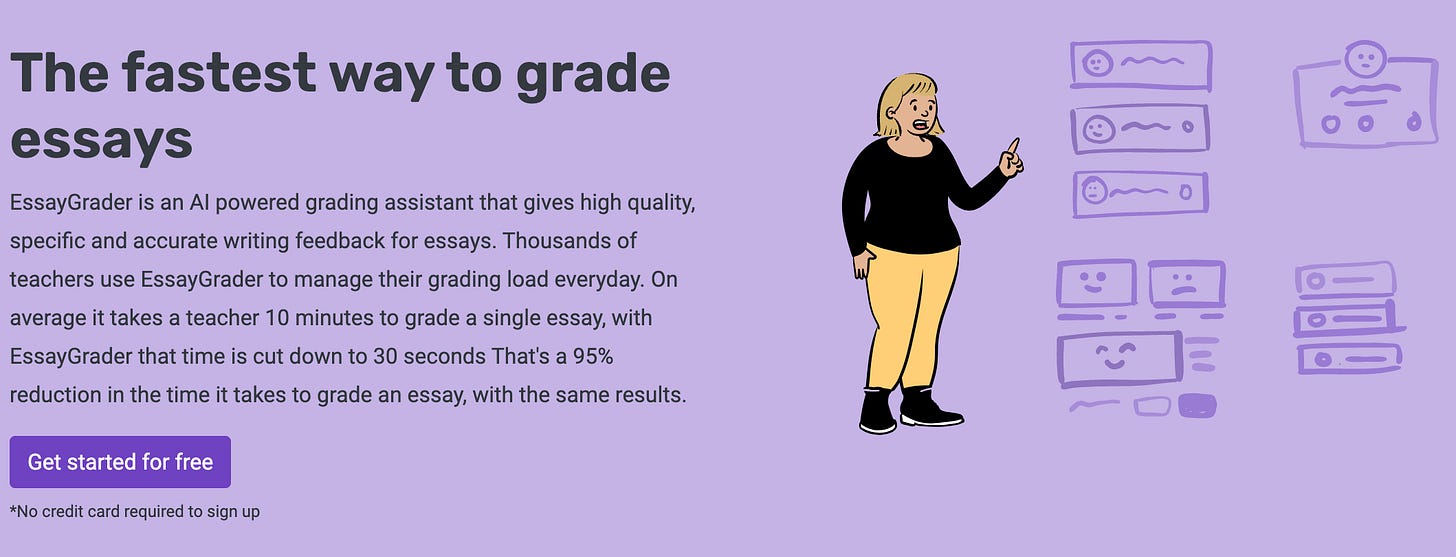AI-Assisted Grading: A Leap Forward or a Step Back?
Investigating the True Cost of Efficiency in Educational Evaluation
“It would be nice if all of the data which sociologists require could be enumerated because then we could run them through IBM machines and draw charts as the economists do. However, not everything that can be counted counts, and not everything that counts can be counted.” - William Bruce Cameron
Today's reflection is sparked by a serendipitous encounter while navigating the ever-expanding universe of educational AI. Amidst a sea of innovations, the promise of a new platform named "EssayGrader" caught my attention. Touted as an AI-powered grading assistant, EssayGrader claims to offer high-quality, specific, and accurate feedback for essay assignments. It's an enticing proposition for educators burdened by the time-consuming task of grading, with the platform boasting a dramatic reduction in grading time—from an average of 10 minutes per essay to a mere 30 seconds. This purported 95% decrease in grading time promises to revolutionize the way teachers manage their workloads, suggesting a future where educators can reclaim valuable hours from the drudgery of marking papers.
But this promise prompts a critical interrogation of what grading entails and what it means to both teachers and students. Can a transition from 10 minutes of human assessment to a 30-second AI evaluation truly yield "the same results"? This question probes deeper than surface-level efficiencies; it beckons us to consider the nuances and complexities of the grading process. What, if anything, is lost in those 9 minutes and 30 seconds saved by an AI graded system? Does the essence of grading lie solely in the act of assigning a numerical value or letter grade to a piece of work, or is there an intrinsic value to the time spent reviewing, assessing, and contemplating student submissions?
This inquiry challenges us to reflect on the broader goals of grading. Is the primary objective to save time? To enhance the accuracy of grades? Or could it be that the act of grading encompasses elements that transcend time efficiency and precision? Perhaps there is a dimension of grading that is inherently bound to the educator's engagement with student work—an engagement that offers insights into the students' understanding, strengths, and potential areas for growth.
As we delve into this exploration, we are compelled to consider the role of AI in education, not just as a tool for operational efficiency, but as a catalyst for reexamining the pedagogical foundations of grading. What does it mean to assess student work, and how do technological advancements align with or diverge from the core educational values of understanding, feedback, and growth?
With the digital transformation of education accelerating, an increasing number of platforms offering AI-powered grading solutions are emerging. This phenomenon is met with a mix of excitement and skepticism among educators. On one hand, the prospect of AI in grading is met with enthusiasm for its potential to streamline cumbersome tasks, freeing up valuable time for teachers to dedicate to more impactful pedagogical activities. On the other hand, there is considerable apprehension about the fairness and accuracy of AI-powered grading systems. Critics voice concerns that these systems may perpetuate or even exacerbate existing biases and inaccuracies in student evaluation, potentially disadvantaging certain student groups. These dual perspectives underscore a complex landscape where the promise of technological innovation intersects with fundamental questions about accuracy, equity and fairness. Yet, these two perceptions may overlook the most crucial aspect of the debate: Is the conversation merely about efficiency and fairness, or are we missing a vital component related to the essence of the assessment process itself?
First, let’s have a look at the apprehension surrounding AI in grading, which echoes a broader historical skepticism toward technological advancement. Humanity has a long history of confronting new technologies with a blend of fear and optimism, often worrying about the potential for technological solutions to lead us astray or exacerbate our challenges. This reaction is not unfounded when it comes to the realm of educational assessment and grading. Well before the advent of AI, educational research has documented significant discrepancies and biases in grading practices. For instance, studies have shown how subjective biases can influence grading, with graders often influenced by their perceptions of a student's behavior or effort rather than the quality of work itself (Ferman & Fontes). Malouff's research further illustrates the variability in grading, highlighting how different educators can assign vastly different grades to the same work due to subjective interpretations (Malouff). Additionally, a study by Gordon and Fay found that students' perceptions of grading fairness were significantly influenced by their exposure to certain teaching practices, underscoring the complex interplay between instructional methods and assessment perceptions (Gordon & Fay). These findings suggest that the issues of bias and inconsistency in grading are not novel but rather are entrenched challenges within the educational system.
Therefore, it's unfair to lay the blame solely at the feet of AI for concerns in grading practices; even before its advent, grading wasn't without its flaws. Indeed, there's a potential that AI-powered grading systems could usher in a new era of more standardized, equitable, and impartial evaluations. By applying algorithms to systematically analyze student submissions against uniform criteria, AI is poised to diminish the impact of personal biases that often sway human grading. Nonetheless, this hopeful perspective must be tempered with an awareness of AI's inherent limitations: although AI has the capacity to alleviate some of the inconsistencies in grading, it lacks the ability to capture the deep, qualitative insights that educators derive from the grading process.
The role of AI in education prompts indeed a reevaluation of the purposes and practices of grading. While AI might offer efficiency and fairness gains, it is crucial to remember that the value of grading extends beyond the mere assignment of scores. Progressive education places a significant emphasis on the process through which knowledge is acquired. This philosophy extends to the realm of grading, transforming it from a mere act of evaluation to a crucial window into the students' intellectual development. Within this framework, grading transcends its traditional role of assigning scores to become a conduit for deepening the educator's understanding of each student's unique learning trajectory.
For educators committed to this approach, the act of grading offers invaluable insights into how students process information, where they excel, and where they encounter obstacles. It allows teachers to uncover patterns in misconceptions and gaps in understanding that might not be visible by simply acknowledging a final grade provided by a machine. This level of insight is instrumental in tailoring instruction to meet the diverse needs of learners, enabling educators to provide targeted feedback that addresses specific areas of difficulty. Through this lens, grading becomes an interactive dialogue between student and teacher, a feedback loop that fosters growth and improvement. Moreover, this pedagogical dimension advocates for a formative approach where the focus is on guiding students' learning journeys rather than merely quantifying their academic performance at a single point in time. This nuanced understanding of grading as a multifaceted tool for enhancing educational outcomes highlights the intrinsic value of the human element in the evaluation and grading process. The process of grading, deeply ingrained in the educator's role, transcends the mere allocation of scores. It embodies a journey of understanding each student's academic path, strengths, and hurdles—an endeavor that AI, despite its potential, cannot fully capture the essence of. The significance lies not in the final grade but in the educator's active participation in the grading process. This participation enables teachers to accumulate a depth of insight into their students' learning experiences, fostering a connection that is crucial for tailored teaching strategies and personalized feedback. While AI may offer assistance in grading, ensuring efficiency and consistency, it's the teacher's involvement that ensures the grading process remains a rich source of knowledge about student progress. Just as learning emphasizes the journey over the destination, grading should be seen as an integral process that enhances the educator's comprehension of student needs, rather than just a means to an end. This perspective ensures that the value of grading as a tool for educators to deeply understand and subsequently guide their students' learning journeys is preserved and cherished.
Integrating AI into the grading process shouldn't diminish the critical role of educators in assessment. Rather, AI ought to act as an augmentative tool, enriching educators' insights into the learning journeys of their students. By striking a careful balance that capitalizes on AI's capabilities while emphasizing the irreplaceable value of teacher involvement in evaluating and grading, educators can refine their grading approaches to be both equitable and educational. It is essential that the incorporation of AI into grading is thoughtfully aligned with core pedagogical values, ensuring that technology serves to enrich, not erode, the intricate and distinctly human aspects of teaching and learning: AI can indeed serve a valuable role in the grading process, not as a replacement but as a collaborator to the teacher, who remains at the heart of the educational journey. This collaboration should empower teachers, providing them with tools that enhance their ability to deeply know and understand their students. In this synergistic relationship, AI acts as an extension of the educator's capacity to assess, enabling a more informed and nuanced approach to understanding each student's unique learning trajectory.
Pascal Vallet - March 2024 - In intellectual partnership with OpenAI's GPT engine to enhance knowledge depth, rhetorical polish, and conceptual clarity within a humanistic framework.
Sources
Assessing knowledge or classroom behavior? Evidence of teachers’ grading bias, Bruno Ferman a, Luiz Felipe, 2022
Bias in Grading, John Malouff, 2010
The Effects of Grading and Teaching Practices on Students’ Perceptions of Grading Fairness, Michael E. Gordon &Charles H. Fay, 2010







